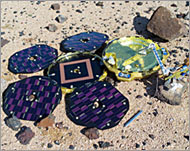Christmas landing for Mars probe
A British probe the size of an open umbrella was due to land on Mars on Thursday and start trying to answer a question which has fascinated mankind for centuries – is there life on the red planet?

Beagle 2, which weighs just 34 kg, is scheduled to open its panoply of parachutes and airbags and float down to the surface of Mars just before 0300 GMT Christmas Day.
The probe will emit a call sign – a tune composed especially for the occasion by British pop group Blur – which scientists hope to pick up on powerful radios aboard a pair of mission rockets orbiting the planet.
The signal will be relayed to earth where the mission’s organisers will be praying in the silent hours for a smooth landing of the craft named after the ship which British naturalist Charles Darwin took to gather the scientific data that formed the basis of his groundbreaking 19th century treatise on evolution: “The Origin of Species”.
“We’ve had no way of monitoring Beagle 2 since it was launched from Mars Express last week,” said Peter Barratt, head of communications for the Beagle 2 team. “But as far as we know it’s on schedule and all is going to plan.”
Potential pitfalls
The probe still faces many potential pitfalls, including huge dust storms sweeping the surface of the volatile planet, 100 million km from earth.
 |
|
This is the first mission of its kind |
If Beagle 2’s parachutes open too soon the tiny craft could be blown away. Too late, and the probe risks ending its life as scrap metal strewn across the forbidding Martian landscape.
Assuming the mission is successful, Beagle 2 will start work straight away. It has an estimated maximum operational life of just 180 days before Martian dust and extremes of temperature are expected to put it out of action.
The lander is packed with state of the art scientific instruments that will scrape, bore and bake samples from the surface of Mars, seeking signs of whether the planet could
sustain life. At its heart is a mass spectrometer used to measure the mass and abundance of atoms and molecules on planetary surfaces.
‘Looking for life’
Colin Pillinger, the brains behind the project, says this is the first mission dedicated to looking for life on Mars rather than simply signs that life once existed.
|
“We would not be doing this if we did not think there was a good chance of success Colin Pillinger |
“We would not be doing this if we did not think there was a good chance of success,” he said.
British bookmaker Ladbrokes cut its odds on Wednesday on the chances of finding life to 25-1 from 33-1 following a flurry of bets since the probe successfully broke free from its mother craft, the Mars Express, last Friday.
Ladbrokes have had a book open on the event since 1969, when man first walked on the moon.
Scientists will be holding an all-night vigil in London to await news of the probe.
If it lands safely, they are likely to crack open a few bottles of Mars Magic, a beer brewed specially for the occasion by a local brewer.